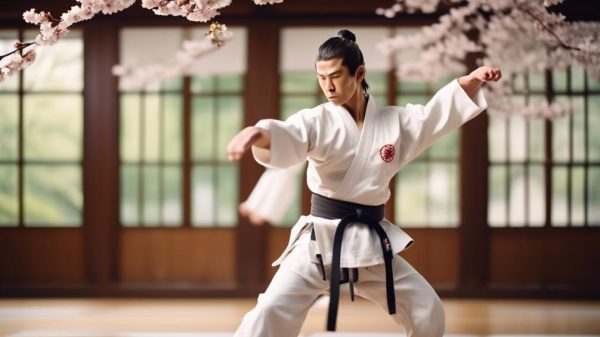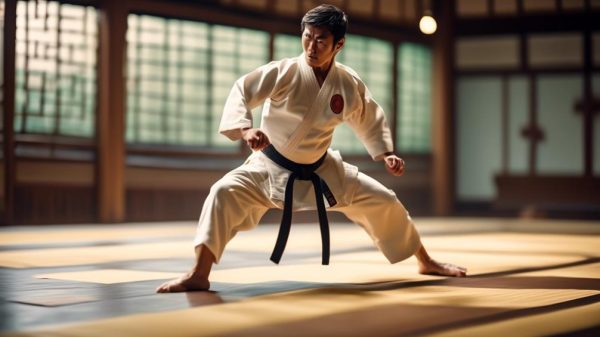Patterns called tul are a key part of taekwondo training. These solo routines or “forms” creatively combine defensive and offensive techniques.
Various punching, blocking, and kicking combos characterize each tul and are practiced in a set sequence of 20+ movements per form. Poise, balance and control mature through repetition.
Tul string specific stances, arm positions, and footwork together rhythmically – almost like dances. Performing pauses called for in the sequences adds suspense!
Beyond physically conditioning, flowing through tuls aims to unify body and mind for reacting instinctively in the heat of confrontation thanks to ingrained motor memory.
Understanding Taekwondo Forms
Taekwondo forms, also known as poomsae, are essential sequences of movements that practitioners master to improve their martial arts skills, embodying discipline and precision.
As a student, you’ll explore the world of ITF Taekwondo patterns and Taegeuk forms, each showcasing unique techniques and complexities.
These forms aren’t just mere routines; they play a critical role in your development, refining your focus, physical fitness, and coordination.
By practicing specific moves, you aren’t merely learning to kick and punch; instead, you’re cultivating a rhythm that translates into effective self-defense skills.
The execution of Taekwondo forms is an art that demands seamless fluidity and balance, especially as you advance through various color belt levels.
The Significance of Poomsae
Understanding the historical roots of poomsae reveals its deep connection to Taekwondo’s heritage.
Practicing poomsae enhances mental discipline, improving focus and fortitude during training.
Additionally, it improves physical coordination, aligning body movements for both defense and attack.
Poomsae’s Historical Roots
Exploring the historical roots of poomsae unveils a rich heritage, embodying the discipline and strategic essence at the core of Taekwondo.
As one delves into mastering these patterns, they’re embracing a tradition deeply entwined with history, surpassing mere physical movements.
- Historical Significance of Poomsae:
- ITF Patterns: Crafted by General Choi, these 24 patterns pay tribute to Korean historical figures.
- WTF Taekwondo: Taegeuk Forms symbolize philosophical elements, emphasizing balance and finesse.
- Palgwe Forms: While less prevalent, they encapsulate ancient principles and strategic cognition.
Through dedicated practice, individuals not only refine their techniques but also connect with the wisdom passed down by past Taekwondo masters.
Mental Discipline Benefits
Engaging in the intricate sequences of poomsae can improve mental discipline, boosting focus and resilience, which are crucial for all Taekwondo practitioners.
Diligent practice of specific movements sharpens concentration, demanding absolute precision and control.
These forms and patterns, endorsed by the World Taekwondo Federation, assist students in practicing offensive and defensive techniques while maintaining composure.
Through continuous refinement and mastery of each form, one’s mental strength grows, making complex sequences second nature.
Enjoy the challenge and let these disciplined routines enhance your focus, elevating your martial arts journey.
Physical Coordination Enhancement
Enhancing physical coordination is essential for executing precise movements in Taekwondo, and practicing poomsae plays a key role in achieving this.
As a dedicated martial arts student aiming for mastery, mastering patterns can significantly improve eye-hand and foot coordination, as well as enhance overall balance.
The significance of this training is apparent in several ways:
- Taekwondo Black Belt Forms
- Mastery of intricate sequences is pivotal for advancing in rank.
- Repetitive practice of specific moves is imperative for achieving perfection.
- Flexibility & Balance
- Flexibility is crucial for executing kicks and stances with ease.
- Poomsae contributes to enhancing a student’s physical prowess and stability.
- Offensive & Defensive Techniques
- Seamlessly transitioning between offensive and defensive techniques is a vital skill to learn.
- Developing the ability to perform techniques with precision and power is essential.
White Belt Basic Patterns
As a novice in Taekwondo, you will begin with the fundamentals of White Belt Basic Patterns. These patterns form the groundwork for your journey in martial arts, teaching essential kicks, strikes, and stances.
The initial sequence consists of 19 movements, aiming to familiarize you with the rhythm and fluidity of Taekwondo.
Mastering these basic patterns is pivotal for your advancement and progression through belt tests.
Your Taekwondo institution utilizes these forms to ensure the establishment of a strong foundation, integrating theoretical knowledge with practical application.
Consistent practice is crucial, and you can further refine your techniques even outside the training facility with resources such as instructional videos.
It’s important to note that each pattern serves a specific purpose.
They are not simply a series of movements; instead, they represent your initial steps in grasping Taekwondo’s language of motion. Here’s an overview of what you will learn:
| Movement Type | Description |
|---|---|
| Kicks | Foundational kicks to enhance balance and coordination. |
| Strikes | Basic hand techniques emphasizing precision. |
| Stances | Fundamental postures for stability and power. |
| Combinations | Sequences integrating kicks, strikes, and stances for fluidity. |
Immerse yourself in these patterns, perfect them through repetition, and you will be on the path to mastery.
Begin now, and let these forms lay the groundwork for your expertise in Taekwondo.
Intermediate Taegeuk Sequences
Intermediate Taegeuk sequences expand upon the fundamentals laid out in White Belt Basic Patterns.
They introduce a more intricate set of movements that will test your precision and control.
As you progress through Taegeuk Forms 4 to 8, each pattern acts as a stepping stone, paving the way for the esteemed Taekwondo Black Belt Forms.
The primary focus lies in refining your martial arts techniques and enhancing your Taekwondo practice by:
- Fluidly executing movements
- Achieving smooth transitions between stances
- Maintaining a consistent rhythm throughout the sequences
- Improving balance
- Stabilizing your center of gravity during complex kicks
- Performing pivots and turns with control
- Heightening agility
- Accelerating and decelerating movements purposefully
- Displaying grace and speed in dodging and weaving
Advanced Black Belt Forms
Embarking on the realm of Advanced Black Belt Forms brings a significant escalation in the complexity of your techniques.
Understanding forms like Koryo and Keumgang goes beyond just mastering the moves; it requires a profound grasp of Taekwondo’s philosophy.
Achieving mastery here entails a blend of agility, precision, and a deep understanding of the art.
Technique Complexity Increase
As you progress to the advanced black belt level in Taekwondo, you’ll encounter forms that significantly increase in technical complexity.
These forms require mastery of intricate movements and precise execution, posing a challenge even for the most dedicated practitioners.
At this stage, practitioners are expected to master difficult or advanced techniques, combining powerful strikes with agile footwork and practicing Taekwondo kicks with precision and control.
Additionally, they’re required to incorporate ITF patterns and standardized movements, dedicating time to form videos and/or written guides to ensure each motion is executed with exactness.
Furthermore, the training aims to enhance physical attributes, focusing on improving muscular strength and flexibility, as well as boosting foot coordination to navigate complex sequences.
Each practice session is a step towards refining the craft, with practitioners repeating certain moves to achieve excellence.
Form Significance Explained
Understanding the deeper significance behind mastering advanced black belt forms, such as Koryo and Keumgang, extends beyond physical prowess.
These forms embody a rich history and philosophy, enhancing the journey of every Taekwondo practitioner.
Recognized by both the World Taekwondo Federation and the International Taekwon-Do Federation, these Taekwondo Black Belt Forms aren’t merely about memorizing standardized movements.
Instead, they invite practitioners to comprehend the underlying purpose of each move.
By practicing and performing these movements with precision, individuals aren’t only preparing for belt tests but also delving into the philosophy and history encapsulated within Taegeuk Forms.
The explained significance within each pattern plays a crucial role in improving students’ stamina, refining offensive and defensive skills, and nurturing a profound connection with the martial art.
It’s important to remember that mastery encompasses not only physical prowess but also intellectual and spiritual growth.
Training Tips for Mastery
To achieve mastery in Taekwondo forms and patterns, it’s essential to dedicate consistent, focused practice. Earning your Taekwondo Black Belt Forms requires time and commitment.
Here are strategies to improve your skills:
- Practice specific moves regularly to develop muscle memory and precision.
- Break down complex sequences into manageable sections.
- Repetition is crucial; drill each segment until it becomes second nature.
- Visualize success by envisioning yourself executing each move flawlessly.
- Integrate patterns into your regular training routine to approach belt tests with confidence.
Schedule consistent training sessions, prioritizing forms practice.
Seek feedback from instructors to refine your techniques.
Challenge yourself with timed drills to simulate test conditions.
Embrace the fitness benefits of Taekwondo for the conditioning required to perform.
Incorporate exercises that enhance stamina and muscle tone.
Engage in cardio workouts to boost endurance for longer training sessions.
Include strength training to increase power behind each move.
Common Mistakes to Avoid
It’s important to be mindful of common errors that can hinder your progress as you perfect your Taekwondo forms and patterns.
Rushing through certain moves should be avoided, as precision and technique are crucial for mastering Taekwondo Black Belt Forms.
Each pattern embodies philosophical concepts, so it’s essential not to overlook their deeper meanings.
When practicing each form, it’s crucial to maintain proper stances and footwork. Your posture and balance must be impeccable to ensure that each technique is executed at the correct height and angle, simulating a real combat scenario.
This attention to detail sets apart students who master the forms recognized by World Taekwondo.
Relying solely on videos should be avoided, as they can’t replace the guidance and feedback from an experienced Taekwondo instructor.
Additionally, don’t underestimate the mental aspect of your training. Visualization and focus are key components in your journey to progress through each belt level.
How Many Taekwondo Black Belt Forms Are There?
Taekwondo black belt forms are an essential part of the journey in martial arts. There are 9 WT black belt forms, each representing a step in Dan ranking.
These forms blend poomsae complexity with martial precision and are vital for grading. They reflect technical mastery and practical application in the progression of your belt.
Why Are There 24 Patterns in Taekwondo?
The 24 patterns in Taekwondo symbolize the journey of life, reflecting the founder’s vision and philosophical roots. They encompass cultural heritage, historical representation, and martial symbolism, emphasizing the discipline of training and the philosophy of movement through numerical symbolism.
How Many Patterns Are There in Taekwondo?
In Taekwondo, you will learn 33 distinct patterns, each emphasizing unique stances, precise movements, and specific breathing techniques.
These elements are essential for grading and signify the historical context, origins, and martial applications of each pattern.








